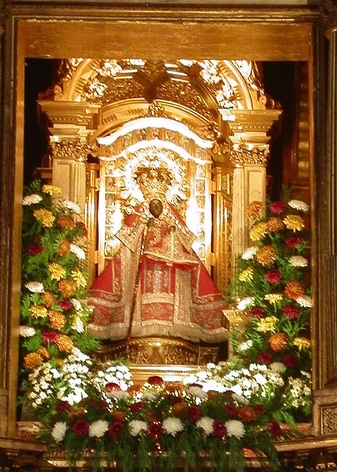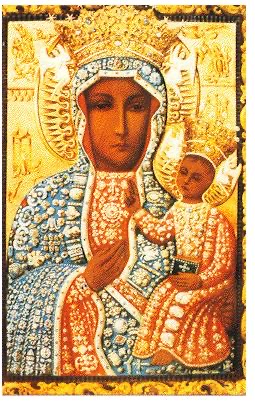When I was on my pilgrimage to Santiago de Compostela in Spain, I had an intention to see a Black Madonna. There are over five hundred of them in Europe.
I found out about the statues while planning my walk from Andalusia, through Extremadura, Castile-Leon, and on to Santiago in Galicia. I did not know where they all were. Surprisingly, one was so close that I could have touched it but the moment did not come to pass. I will talk about that later.
Our Lady of Guadalupe, Extremadura
The shrine to Our Lady of Guadalupe was the most important Marian (of Mary) shrine in the medieval kingdom of Castile. This Black Madonna is enshrined in the Monastery of Santa Maria de Guadalupe, at Cáceres in Extremadura.

I knew there was a Black Madonna in Cáceres and had even planned to stop there. As I detailed in a previous post, I walked past the shrine but did not visit her.
La Moreneta at Monserrat, Catalonia
This statue is near Barcelona.
The Montserrat Black Madonna is the patron saint of Catalonia – declared so by Pope Leo XIII in 1881. Catalan celebrates her day on April 27th.

The statue was canonically crowned on 12 October 1928 by Pope Pius XI in the presence of King Alfonso XII of Spain. The crown was designed and crafted by Father Felix Granda.
Black Madonna, Santiago de Compostela
The Black Madonna at Santiago de Compostela was unknown to me until I returned home. It is a replica of “La Moreneta” that exists there.
So, I literally walked past this Black Madonna during my pilgrimage.
The relics or concept of saints even existing in Compostela is explained with a dose of treachery and secrecy. Saint James the Moor Slayer is the focus of most pilgrims to Santiago. Is he relevant to the modern age or to me – a black woman – in these times of worldly and planetary strife?
A Black Madonna would have been more relevant for a pilgrimage to me. That would make a little more sense. I do not lean on denials and contradictions but toward clarity and authentic understanding. As a result, my interest in religion is cool and distant.
Mystery in all things
I witnessed a lot of hypocrisy and contradictions in the name of religion in my life. Believing, in my childhood eyes, meant accepting things I do not see and denying that which I do see. It has not brought me any closer to any real religious beliefs. I’ve taken that view all the way to adulthood.
However, I respect the effect of these beliefs on people who base their entire being and soul in these things – sight unseen – without question, seeking salvation in this world.
She who reconciles the ill-matched threads Of her life, and weaves them gratefully Into a single cloth –
It’s she who drives the loudmouths from the hall
And clears it for a different celebration where the one guest is you.
In the softness of the evening it’s you she receives.
You are the partner of her loneliness, the unspeaking center of her monologues.
With each encounter you encompass more and she stretches beyond what limits her, to hold you.
– Rainer Maria Rilke, Book of Hours: Love Poems to God
Why is the Madonna Black?
One of the most common questions about the Black Madonna is why she is black. The dark colour of the Virgin’s face is the reason why locals have nicknamed her ‘La Moreneta’ (the little black lady).

The Holy Image without the false dresses
by Desconegut – Girona City Council, Spain
– Public Domain.*
Contrary to popular belief, she is not black due to a portrayal of a Black African Madonna. The blackness also does not come from a dark colour in the wood or from earlier coverings in the paint. It is known from historical descriptions of the Madonna that she has simply darkened over time.
Really?
The image of the Black Madonna in Montserrat is, alas, not the one from the old legends. It is instead a Romanesque carving from around the 12th century.
Following the Romanesque tradition, the Mother of Jesus is presented in a static way with the Child on her lap – more a throne for the Savior than a loving mother. She measures 95cm (3.1 feet) and is made out of poplar wood. Her skin is dark and her clothes golden.
She holds a sphere on her right hand, which has been interpreted as the universe – a symbol of power. The child holds instead an evergreen pine cone – symbol of eternal life.
There are gifts and talents that have not yet been used and power which has not been applied.
– Sunday Adelaja
But Why is She Black?
The Virgin of Montserrat is a Black Madonna: her skin is dark. The admonishment is to not see her as of African origin.
Old records show her skin light. Modern restorations suggest that at first the smoke of the candles surrounding the image started sooting it. And maybe particles in the ancient paint and varnish covering it rusted, too, darkening its surface. Until around the 1500’s it was painted in a light brown color, probably thinking they were returning it to its original color.
Another layer of dark brown paint dating from the 1800’s was added. By then the locals had already given her the sweet nickname of “La Moreneta”, the little sun-tanned girl. For them it would have been a shock to have been cleaned back to a whiter color. And that’s how she got to our times being a Black Virgin.
Venerating the Black Virgin of Montserrat
The Black Madonna of Montserrat is one of 51 Black Virgins in Spain, and ranks as the second most important. The Virgen del Pilar from Zaragoza and the Virgen de Guadalupe from Extremadura are tied for the title of female patron saints of Spain.
Black Madonna of The Ozarks
A Black Madonna exists in North America, in the state of Missouri.

Black Madonna of The Ozarks is a copy based on the Black Madonna of Częstochowa, in Poland.
The shrine in the U.S. has been burned, attacked, and robbed, yet it stands. I think that is proof to me that the lady is tough. She survives here in the same hostile space as do people of the darker hue.
Though I am back home, it appears that I am still continuing on my pilgrimage to Santiago de Compostela.
A Mystery
For some reason, I missed the Black Madonna. Yes, missed it. And I was in Santiago two different times before I left Spain. Well, I think I know why. I am working on resolving this mystery.
It is clear to me that the pilgrim’s journey seeking answers to a lifetime of questions did not end there. It was not meant to.
Baadaye
Shirley J ♥️
____
- Guadalupe (Province of Cáceres): Nuestra Señora de Guadalupe (Our Lady of Guadalupe, Extremadura)
An interesting article on Black Madonna:
- Black Madonna of the Ozarks, by Richard Bauman, The Catholic Herald, 03/18/13
*(image: from The Black Madonnas Of Europe: Miracle Workers and Holy Icons, Atlanta Black Star,
Posted by Rumoko Rashidi, March 26, 2014 | Updated on July 6, 2014)
**(www.europeana.eu/item/2024914/
photography_ProvidedCHO_Ajuntament_de_Girona_
351137)

